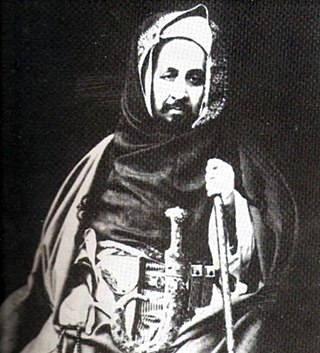
The siege of Kut Al Amara, also known as the first battle of Kut, was the besieging of an 8,000 strong British Army garrison in the town of Kut, 160 km (100 mi) south of Baghdad, by the Ottoman Army. In 1915, its population was around 6,500. Following the surrender of the garrison on 29 April 1916, the survivors of the siege were marched to imprisonment at Aleppo, during which many died. Historian Christopher Catherwood has called the siege "the worst defeat of the Allies in World War I". Ten months later, the British Indian Army, consisting almost entirely of newly recruited troops from Western India, conquered Kut, Baghdad and other regions in between in the Fall of Baghdad.

Omar al-Mukhṭār Muḥammad bin Farḥāṭ al-Manifī, called The Lion of the Desert, known among the colonial Italians as Matari of the Mnifa, was an Imam and leader of native resistance in Cyrenaica under the Senussids, against the Italian colonization of Libya. A teacher-turned-general, Omar was a prominent figure of the Senussi movement and he is considered the national hero of Libya and a symbol of resistance in the Arab and Islamic worlds. Beginning in 1911, he organised and led the Libyan resistance movement against the Italian colonial empire during the First and Second Italo-Senussi Wars. Externally, he also fought against the French colonization of Chad and the British occupation of Egypt. After many attempts, the Italian Armed Forces managed to capture Al-Mukhtar near Slonta when he was wounded in battle by Libyan colonial troops, and hanged him in 1931 after he refused to surrender.

Bir Hakeim is the site of a former Ottoman fort in the Libyan desert. The fort was built around the site of an ancient Roman well, dating to the period when the oasis was part of Ottoman Tripolitania. It is about 160 km (99 mi) west of Sollum on the Libyan coast and 80 km (50 mi) south-east of Gazala. Bir Hakeim is best known for the battle of Bir Hakeim, which took place there during World War II.
Tarhuna, also Tarhoona or Tarhunah, is a Libyan village 65 kilometres (40 mi) to the southeast of Tripoli, in the Murqub District. The Tarhuna District, including the city of Msallata, had an urban population of about 296,000. The population in Tarhuna proper was calculated to be 13,264 in 2011.

Abu al-Walid was a Saudi Arabian of the Ghamd tribe who fought as a "mujahid" volunteer in Central Asia, the Balkans, and the North Caucasus. He was killed in April 2004 in Chechnya by the Russian federal forces.

The Senussi campaign took place in North Africa from November 1915 to February 1917, during the First World War. The campaign was fought by the Kingdom of Italy and the British Empire against the Senussi, a religious order of Arabic nomads in Libya and Egypt. The Senussi were courted by the Ottoman Empire and the German Empire. In the summer of 1915, the Ottomans persuaded the Grand Senussi Ahmed Sharif as-Senussi to declare jihad, attack British-occupied Egypt from the west and to encourage insurrection in Egypt to divert British forces.

Italian Tripolitania was an Italian colony, located in present-day western Libya, that existed from 1911 to 1934. It was part of the territory conquered from the Ottoman Empire after the Italo-Turkish War in 1911. Italian Tripolitania included the western northern half of Libya, with Tripoli as its main city. In 1934, it was unified with Italian Cyrenaica in the colony of Italian Libya. In 1939, Tripolitania was considered a part of the Kingdom of Italy's 4th Shore.
Zawiat at-Taban, or Taban ; also An-Nayan or Wadi Sammalus, is a check point in the District of Jabal al Akhdar in north-eastern Libya. It is located on the cross-roads between the Charruba–Mechili–Timimi desert road and the Marawa–Wadi Sammalus.

The Battle of Wadi, occurring on 13 January 1916, was an unsuccessful attempt by British forces fighting in Mesopotamia during World War I to relieve beleaguered forces under Sir Charles Townshend then under siege by the Ottoman Sixth Army at Kut-al-Amara.

Conflicts took place in North Africa during World War I (1914–1918) between the Central Powers and the Entente and its allies. The Senussi of Libya sided with the Ottoman Empire and the German Empire against the British Empire and the Kingdom of Italy. On 14 November 1914, the Ottoman Sultan proclaimed a jihad and sought to create a diversion to draw British troops from the Sinai and Palestine Campaign. Italy wished to preserve its gains from the Italo-Turkish War. The Senussi Campaign took place in North Africa from 23 November 1915 to February 1917.

Ahmed Sharif as-Senussi was the supreme leader of the Senussi order (1902–1933), although his leadership in the years 1917–1933 could be considered nominal. His daughter, Fatimah el-Sharif was the Queen consort of King Idris I of Libya.

The Action of Agagia took place east of Sidi Barrani in Egypt on 26 February 1916, during the Senussi Campaign between German and Ottoman-instigated Senussi forces and the British army in Egypt. On 11 December 1915, a British column had been attacked at Duwwar Hussein along the Matruh–Sollum track. In the Affair of Wadi Senba, the Senussi were defeated and two days later a Senussi attack at Wadi Hasheifiat was repulsed. The British returned to Matruh until 25 December, then surprised the Senussi at the Affair of Wadi Majid but the Senussi got away. At the Affair of Halazin on 23 January, the Senussi were defeated and again slipped away.

The Battle of Tripoli, sometimes referred to as the Fall of Tripoli, was a military confrontation in Tripoli, Libya, between loyalists of Muammar Gaddafi, the longtime leader of Libya, and the National Transitional Council, which was attempting to overthrow Gaddafi and take control of the capital. The battle began on 20 August 2011, six months after the First Libyan Civil War started, with an uprising within the city; rebel forces outside the city planned an offensive to link up with elements within Tripoli, and eventually take control of the nation's capital.
The Battle of Gasr Bu Hadi occurred during the Italian colonization of Libya. It was the worst Italian defeat since the Battle of Adwa.

The Bir Hakeim rescue was a British raid in Italian Cyrenaica on 17 March 1916 to recover prisoners of war held by the Senussi. Following the capture of Sollum on 14 March the British discovered evidence that the prisoners, survivors from two ships sunk by a German U-boat, were being held at the Bir Hakeim oasis, about 99 mi (160 km) to the west.
The Battle of Al-Rahiba was a military engagement between the Senussi order led by Omar al-Mukhtar and the Italians. The Senussi won a resounding victory against the Italians.
The Battle of Wadi Marsit was a military engagement between the Senussi order and the Italians. The Senussi won a major victory against the Italians.
The Battle of Bir Tabraz was fought in December 1911 during the Italo-Turkish War between the Kingdom of Italy and Senussi forces in a place near Tripoli in modern Libya, the Senussi successfully forced to Italians to withdraw.
The Battle of Safsaf was fought in July 1913 between the Kingdom of Italy and Senussi forces in a place near Safsaf, Libya in modern Libya. The Senussi succeeded in defeating two Italian forces.
The Battle of Bir Bilal was a military engagement between the Senussi order and the Italians. The Senussi won a resounding victory against the Italians.











